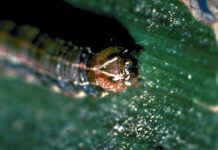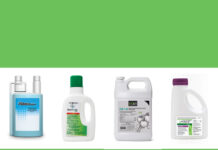
Do you suspect your customer’s lawn has a problem with grubs? If so, preventative measures are the most effective. They get better results, are more targeted, and now (from June to July) is the time to apply them.
Grubs, which are the larval, or immature, stage of several species of beetles and chafers, damage a lawn by feeding on the grass roots. While healthier grass can tolerate more grub feeding—and all grass can tolerate some grub feeding—a grub infestation will cause patches of thinning turf that gradually increase in size. Grub damaged grass will often pull out very easily at the roots. Grub damage typically appears two times a year: from March to early May and from August to late Autumn (October/ November) depending on your region. More on this timing later.
Is It Really Grubs?
Turf issues that resemble grub damage can be caused by something else, including disease, drought stress, hairy chinch bugs, sod webworms, shade, compaction, and more. The only way to be sure grubs are the true problem is to scout for them in a lawn, says Dr. Nate Bernitz of the University of New Hampshire.
- Using a shovel or a lawn edger, make a cut in a 1’ section of lawn where you suspect grub activity.
- Peel up a one square-foot section of grass and soil from that cut. If there is significant grub damage, the grass should peel up quite easily.
- Sift around in the soil, counting the number of grubs found. Ten or more grubs per square foot is a serious infestation. Finding a few grubs is normal and not cause for concern.
Depending on the lawn size, you may want to scout for grubs in several places, focusing on areas that are showing symptoms of feeding. Just because there are a lot of grubs, or not a lot of grubs, in a particular square foot doesn’t mean the entire lawn does or doesn’t have an infestation. Take notes so you remember which areas of the property have high counts and which don’t. This is important if and when you decide to treat the lawn.
Healthy turf can support a grub population of five or more grubs per square foot with no visible turf damage. A very high concentration of grubs – 10 or more grubs per square foot – may require treatment to maintain healthy grass.
Grub Life Cycle
In order to treat grubs effectively, applying the right product at the right timing of the year-long grub life cycle is key. We’ll start with Winter to represent a typical landscape maintenance schedule.
During the Winter, large grubs (.75″ long) born the previous Summer, overwinter about two to six inches below the soil surface. When the ground warms up in Spring, they begin feeding and can cause damage from the time the grass turns green until about mid-May. At this point, they finish feeding, and transform into a pupae in the soil, where they then remain for several weeks until becoming an adult beetle.

Adult beetles emerge in early Summer, and then lays eggs in the soil during June to early August. The eggs hatch about 10 days after they are laid and this next generation of grubs feeds from the beginning of August until late Autumn, then overwinters, and feeds again in the Spring.
Timing & Treatment Options
Due to this cycle, pesticide application in June and July targets small, newly hatched grubs, making it the most effective treatment. Preventive products in the neonicotinoid class of insecticides containing imidacloprid, thiamethoxam, or clothianidin will consistently reduce 75% to 100% of the grubs if they are applied in June or July and if they are watered-in with 0.5″ of irrigation immediately after application, according to experts David Smitley, Terry Davis, and Erica Hotchkiss, in the Michigan State University, Department of Entomology.
It’s important to note that these active ingredients do not work well for the larger grubs found from September to May–although labels often say apply anytime from May to August 15. If applied in early Spring, the pesticide may move through the soil or partially degrade by the time young grubs hatch in late July. If applied too late, the grubs may be too large for preventative products to be effective.

A relatively new active ingredient for grub control is tetraniliprole, introduced in Envu’s (formerly Bayer) Tetrino in mid 2021. According to Envu, tetraniliprole moves systemically through the plant through xylem distribution. This causes immediate feeding cessation and therefore fast, visible benefits to the plant following exposure. With a slightly longer application window than the ingredients listed above, it’s best applied in late June through early August. A full rate of Tetrino (32 oz/acre) is recommended for season-long grub control. It can also be applied in a split application (16 oz/acre + 16 oz/acre) in late Spring and again in mid-late Summer to target a wider range of pests throughout the season including billbugs, chinch bugs, and caterpillars like sod webworm, cutworms and Fall armyworms.
Another active ingredient, chlorantraniliprole, will also work in preventing grub problems and can be applied as early as April and up to June/July (depending on your geographic region). However, research has shown that applications made in April or May are more effective than June or July applications—something to keep in mind for 2024. This chemical also controls caterpillars such as webworms and armyworms and consistently reduced grub numbers by about 65% to 80%. The U.S. EPA designates this chemical as a low risk pesticide due to its low toxicity to bees and other beneficial insects.
Several preventative products include both a neonicotinoid and a pyrethroid, which provides control not only for grubs but also caterpillars, billbugs, and some other lawn insect pests. Some products registered for controlling grubs just have a pyrethroid, such as products with the active ingredient gamma-cyhalothrin. According to research from Michigan State University, products that only contain lambda-cyhalothrin, gamma-cyhalothrin, bifenthrin, deltamethrin, cyfluthrin, or permethrin do not work for grub control.
In late Summer and Fall, only curative products can be used to effectively control grub populations. Ingredients such as carbaryl or trichlorfon are curative and work on contact with grubs and kill all life stages. These products can be effective, but are broad-spectrum and have a low residual, so they also kill beneficial insects on contact. Their effectiveness is also variable, with wide ranging results. Research at Michigan State indicates they will kill 20% to 80% of grubs when applied in September or only 20% to 55% when applied in late October. These products should be watered in well, immediately after application.
To help protect pollinators, before applying any insecticides, the lawn should be mowed prior to application so there aren’t weeds flowering in the lawn while the product is being applied. Also be conscious of drift. If it’s windy and you spray an area of the lawn, there’s a chance the product could drift onto flowering plants nearby. Likewise, if you’re using a spreader for a granular product, ensure you limit your application to lawn areas that have a grub infestation. There’s little reason to apply any of these products to an entire lawn if only a section of the lawn has a grub infestation. Also keep in mind that products designed to be used for grubs in the lawn are not designed for use in gardens.
Natural Treatments
The two natural products that have gotten attention are milky spore and beneficial nematodes. Milky spore is a bacterium that is effective for controlling Japanese beetle larvae, provided Spring soils are sufficiently warm. Milky spore may be worth a try if you are sure the grubs are the larvae of Japanese beetles (identifying grub species requires a hand-lens because the differences are very subtle) and can wait several years to achieve good results. One resource for white grub identification is a fact sheet from UMass Extension.
Beneficial nematodes (there are also are non-beneficial nematodes depending on which host they attack) are microscopic worms and can work very well for controlling grubs in residential lawns. Some species of nematodes only control certain species of grubs, so just like with milky spore, identifying the species of grubs is important. Nematodes also need to be applied when the species of grubs they control are active in the soil. To successfully use nematodes for grub control, keep the following principles in mind:
- The lawn needs to be well watered and the soil can’t go dry while the nematodes are getting established.
- The nematodes need to be viable (living) when applied. Purchasing nematodes from a reputable supplier and applying them right away are important.
- Apply the appropriate species of nematode at the appropriate time of year.
- Apply them on an overcast day or in the early morning. Nematodes are sensitive to light and can be killed within a minute if exposed to intense direct sunlight.
- If nematodes are being used curatively, they may need to be applied every two to three weeks until the infestation subsides. For those who use nematodes preventatively, they should be applied two to three times a season.
Information for this article was sourced from:
Controlling Grubs: Fall Options & Spring Plans by Nate Bernitz at the University of New Hampshire Extension, Turf, October 2020
“How to choose and when to apply grub control products for your lawn” by David Smitley, Terry Davis, and Erica Hotchkiss from Michigan State University, Dept. Of Entomology, May 22, 2020











![[VIDEO] Dickies®: Discover Workwear That’s Anything But Uniform](https://turfmagazine.com/wp-content/uploads/2023/06/1647663814-4b1a2a7742790a9b1e97a3b963477850192e1d6a9dfba9b07214a77bae25d6e3-d-218x150.jpg)





























![[VIDEO] Dickies®: Discover Workwear That’s Anything But Uniform](https://turfmagazine.com/wp-content/uploads/2023/06/1647663814-4b1a2a7742790a9b1e97a3b963477850192e1d6a9dfba9b07214a77bae25d6e3-d-324x160.jpg)